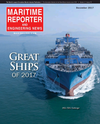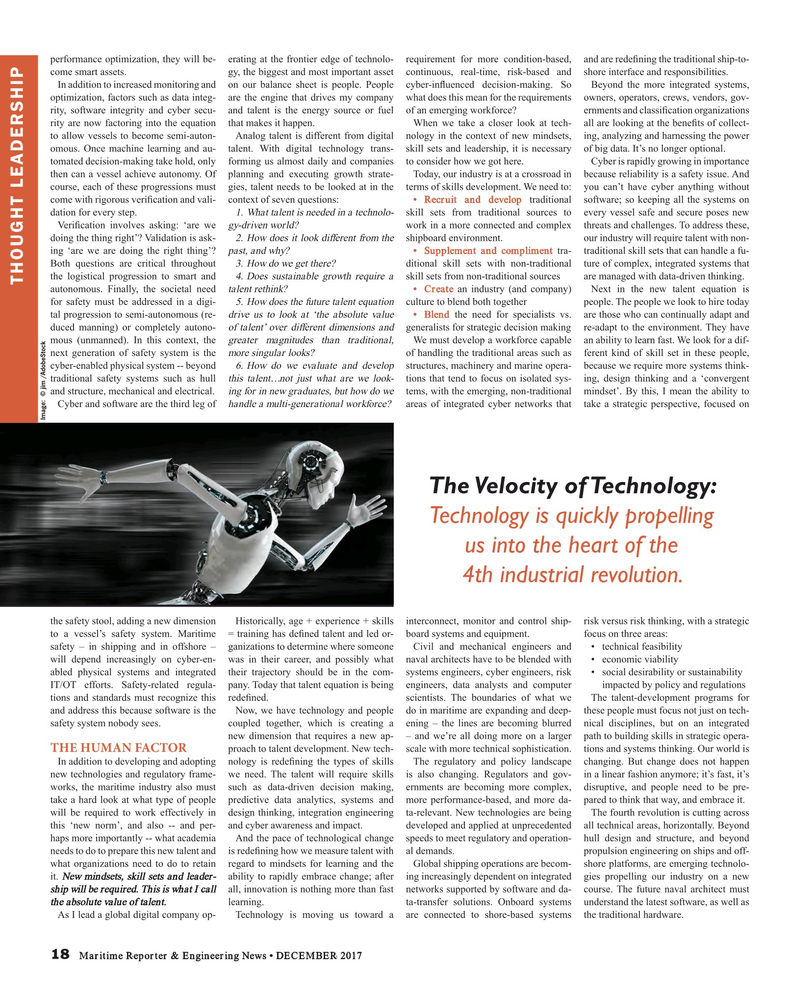
Page 18: of Maritime Reporter Magazine (December 2017)
U.S. Navy Quarterly
Read this page in Pdf, Flash or Html5 edition of December 2017 Maritime Reporter Magazine
performance optimization, they will be- erating at the frontier edge of technolo- requirement for more condition-based, and are rede? ning the traditional ship-to- come smart assets. gy, the biggest and most important asset continuous, real-time, risk-based and shore interface and responsibilities.
In addition to increased monitoring and on our balance sheet is people. People cyber-in? uenced decision-making. So Beyond the more integrated systems, optimization, factors such as data integ- are the engine that drives my company what does this mean for the requirements owners, operators, crews, vendors, gov- rity, software integrity and cyber secu- and talent is the energy source or fuel of an emerging workforce? ernments and classi? cation organizations rity are now factoring into the equation that makes it happen. When we take a closer look at tech- all are looking at the bene? ts of collect- to allow vessels to become semi-auton- Analog talent is different from digital nology in the context of new mindsets, ing, analyzing and harnessing the power omous. Once machine learning and au- talent. With digital technology trans- skill sets and leadership, it is necessary of big data. It’s no longer optional.
tomated decision-making take hold, only forming us almost daily and companies to consider how we got here. Cyber is rapidly growing in importance then can a vessel achieve autonomy. Of planning and executing growth strate- Today, our industry is at a crossroad in because reliability is a safety issue. And course, each of these progressions must gies, talent needs to be looked at in the terms of skills development. We need to: you can’t have cyber anything without come with rigorous veri? cation and vali- context of seven questions: • Recruit and develop traditional software; so keeping all the systems on dation for every step. 1. What talent is needed in a technolo- skill sets from traditional sources to every vessel safe and secure poses new
Veri? cation involves asking: ‘are we gy-driven world? work in a more connected and complex threats and challenges. To address these, doing the thing right’? Validation is ask- 2. How does it look different from the shipboard environment. our industry will require talent with non- ing ‘are we are doing the right thing’? past, and why? • Supplement and compliment tra- traditional skill sets that can handle a fu-
Both questions are critical throughout 3. How do we get there? ditional skill sets with non-traditional ture of complex, integrated systems that the logistical progression to smart and 4. Does sustainable growth require a skill sets from non-traditional sources are managed with data-driven thinking.
THOUGHT LEADERSHIP autonomous. Finally, the societal need talent rethink? • Create an industry (and company) Next in the new talent equation is for safety must be addressed in a digi- 5. How does the future talent equation culture to blend both together people. The people we look to hire today tal progression to semi-autonomous (re- drive us to look at ‘the absolute value • Blend the need for specialists vs. are those who can continually adapt and duced manning) or completely autono- of talent’ over different dimensions and generalists for strategic decision making re-adapt to the environment. They have mous (unmanned). In this context, the greater magnitudes than traditional, We must develop a workforce capable an ability to learn fast. We look for a dif- next generation of safety system is the more singular looks? of handling the traditional areas such as ferent kind of skill set in these people, cyber-enabled physical system -- beyond 6. How do we evaluate and develop structures, machinery and marine opera- because we require more systems think- traditional safety systems such as hull this talent…not just what are we look- tions that tend to focus on isolated sys- ing, design thinking and a ‘convergent and structure, mechanical and electrical. ing for in new graduates, but how do we tems, with the emerging, non-traditional mindset’. By this, I mean the ability to
Cyber and software are the third leg of handle a multi-generational workforce? areas of integrated cyber networks that take a strategic perspective, focused on
Image: © jim /AdobeStock
The Velocity of Technology:
Technology is quickly propelling us into the heart of the 4th industrial revolution.
the safety stool, adding a new dimension Historically, age + experience + skills interconnect, monitor and control ship- risk versus risk thinking, with a strategic to a vessel’s safety system. Maritime = training has de? ned talent and led or- board systems and equipment. focus on three areas: safety – in shipping and in offshore – ganizations to determine where someone Civil and mechanical engineers and • technical feasibility will depend increasingly on cyber-en- was in their career, and possibly what naval architects have to be blended with • economic viability abled physical systems and integrated their trajectory should be in the com- systems engineers, cyber engineers, risk • social desirability or sustainability
IT/OT efforts. Safety-related regula- pany. Today that talent equation is being engineers, data analysts and computer impacted by policy and regulations tions and standards must recognize this rede? ned. scientists. The boundaries of what we The talent-development programs for and address this because software is the Now, we have technology and people do in maritime are expanding and deep- these people must focus not just on tech- safety system nobody sees. coupled together, which is creating a ening – the lines are becoming blurred nical disciplines, but on an integrated new dimension that requires a new ap- – and we’re all doing more on a larger path to building skills in strategic opera-
THE HUMAN FACTOR proach to talent development. New tech- scale with more technical sophistication. tions and systems thinking. Our world is
In addition to developing and adopting nology is rede? ning the types of skills The regulatory and policy landscape changing. But change does not happen new technologies and regulatory frame- we need. The talent will require skills is also changing. Regulators and gov- in a linear fashion anymore; it’s fast, it’s works, the maritime industry also must such as data-driven decision making, ernments are becoming more complex, disruptive, and people need to be pre- take a hard look at what type of people predictive data analytics, systems and more performance-based, and more da- pared to think that way, and embrace it.
will be required to work effectively in design thinking, integration engineering ta-relevant. New technologies are being The fourth revolution is cutting across this ‘new norm’, and also -- and per- and cyber awareness and impact. developed and applied at unprecedented all technical areas, horizontally. Beyond haps more importantly -- what academia And the pace of technological change speeds to meet regulatory and operation- hull design and structure, and beyond needs to do to prepare this new talent and is rede? ning how we measure talent with al demands. propulsion engineering on ships and off- what organizations need to do to retain regard to mindsets for learning and the Global shipping operations are becom- shore platforms, are emerging technolo- it. New mindsets, skill sets and leader- ability to rapidly embrace change; after ing increasingly dependent on integrated gies propelling our industry on a new ship will be required. This is what I call all, innovation is nothing more than fast networks supported by software and da- course. The future naval architect must the absolute value of talent. learning. ta-transfer solutions. Onboard systems understand the latest software, as well as
As I lead a global digital company op- Technology is moving us toward a are connected to shore-based systems the traditional hardware.
18 Maritime Reporter & Engineering News • DECEMBER 2017
MR #12 (18-25).indd 18 MR #12 (18-25).indd 18 12/6/2017 11:49:55 AM12/6/2017 11:49:55 AM

 17
17

 19
19
